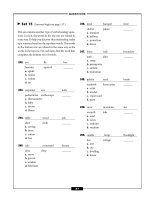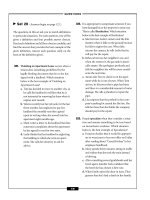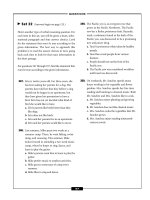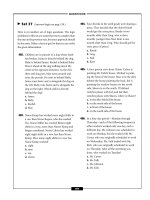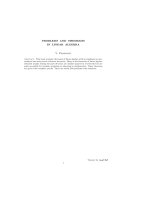50 challenging algebra problems (fully solved)
Bạn đang xem bản rút gọn của tài liệu. Xem và tải ngay bản đầy đủ của tài liệu tại đây (19.75 MB, 226 trang )
50 CHALLENGING
ALGEBRA PROBLEMS
(Fully Solved)
Improve Your Math Fluency
Chris McMullen, Ph.D.
Copyright © 2018 Chris McMullen, Ph.D.
www.improveyourmathfluency.com
All rights reserved. However, teachers or parents who purchase one copy of
this workbook (or borrow one physical copy from a library) may make and
distribute photocopies of selected pages for instructional (non-commercial)
purposes for their own students or children only.
Zishka Publishing
ISBN: 978-1-941691-23-6
Textbooks > Math > Algebra
Study Guides > Workbooks> Math
Education > Math > Algebra
www.pdfgrip.com
www.pdfgrip.com
Contents
Problems 1-5
Problems 6-10
Problems 11-15
Problems 16-20
Problems 21-25
Problems 26-30
Problems 31-35
Problems 36-40
Problems 41-45
Problems 46-50
ABOUT THE AUTHOR
www.pdfgrip.com
Problem 1
Directions: Solve for x in the equation below. (Don’t use guess and check.)
• You can find the solution on the following page.
www.pdfgrip.com
Solution to Problem 1
Subtract
from both sides of the equation in order to isolate the
unknown term.
Square both sides of the equation to get the variable out of the squareroot.
and (a – b)2 = a2 – 2ab + b2 where
Apply the rules
and
Apply the rules
.
and
www.pdfgrip.com
.
Note that 32 + 2 = 34 and (32)(2) = 64.
Note that
.
x = 34 – (2)(8)
x = 34 – 16
x = 18
Check the answer: Plug x = 18 into the original equation.
Use a calculator.
4.242640687 + 1.414213562 = 5.656854249
www.pdfgrip.com
The answer checks out.
Common mistake: It’s incorrect to rewrite
as x + 2 = 32. You can easily verify that x doesn’t equal 30 by plugging 30 in
for x in the original equation with a calculator. You can’t square each term
individually in algebra. You can square both sides of the equation, but then
you get a cross term when you f.o.i.l. it out:
That’s why x + 2 = 32 is incorrect. It should really be
www.pdfgrip.com
Problem 2
Directions: Solve for x and y in the system of equations below.
www.pdfgrip.com
• You can find the solution on the following page.
www.pdfgrip.com
Solution to Problem 2
Subtract y from both sides of the first equation.
x = 16 – y
Substitute 16 – y in place of x in the second equation.
Add the left fractions by first making a common denominator. Multiply
by
denominator.
and multiply
by
www.pdfgrip.com
in order to make a common
To add fractions that share a common denominator, add their numerators.
www.pdfgrip.com
Cross multiply. Recall that
multiply.
becomes wz = xy when you cross
(16)(3) = (1)(16y – y2)
48 = 16y – y2
This is a quadratic equation. First express the equation in standard form.
y2 – 16y + 48 = 0
Either factor this equation or apply the quadratic formula. We will factor it.
(y – 4)(y – 12) = 0
The two solutions are y = 4 and y = 12. Plug each solution into x = 16 – y.
The two corresponding solutions are x = 12 and x = 4.
Check the answers: Plug x = 4 and y = 12 into the original equations.
You will get the same thing using x = 12 and y = 4. The answers check out.
www.pdfgrip.com
Problem 3
Directions: Solve for x in the equation below, where x is a positive real
number.
2x4/3 + 5x3/4 = 6x4/3 – 3x3/4
• You can find the solution on the following page.
www.pdfgrip.com
Solution to Problem 3
Combine like terms: Add 3x3/4 to both sides and subtract 2x4/3 from both
sides.
5x3/4 + 3x3/4 = 6x4/3 – 2x4/3
Note that 5x3/4 + 3x3/4 = 8x3/4 and 6x4/3 – 2x4/3 = 4x4/3. One way to see this is
to factor: For example, 5x3/4 + 3x3/4 = (5 + 3) x3/4 = 8x3/4.
8x3/4 = 4x4/3
Divide both sides of the equation by 4.
2x3/4 = x4/3
Divide both sides of the equation by x3/4. (The problem states that x is
positive, so we don’t need to worry about dividing by zero.) Note that
.
www.pdfgrip.com
Apply the rule
.
2 = x4/3–3/4
Subtract fractions by making a common denominator. Focus on the exponent.
Since 4/3 – 3/4 equals 7/12, the previous equation can be expressed as:
2 = x7/12
Raise both sides of the equation to the power of 12/7. Why? We will apply
the rule that (xm)n = xmn such that (xm)1/m = xm(1/m) = x1 = x.
212/7 = (x7/12)12/7
212/7 = x
If you enter 212/7 on a calculator, you will find that x ~ 3.281341424.
Check the answer: Plug x ~ 3.281 into the original equation. Use a
calculator.
2x4/3 + 5x3/4 = 6x4/3 – 3x3/4
2(3.281)4/3 + 5(3.281)3/4 = 6(3.281)4/3 – 3(3.281)3/4
9.751 + 12.189 ~ 29.252 – 7.314
Since this works out to 21.940 ~ 21.938, the answer checks out.
www.pdfgrip.com
Problem 4
Directions: Determine the value of x in the equation below.
xx = 256
• You can find the solution on the following page.
www.pdfgrip.com
Solution to Problem 4
Solving for x by applying algebraic operations to both sides of this equation
would be challenging. However, it turns out that this problem is numerically
simple enough to figure out if you understand what the problem means
conceptually.
The problem, xx = 256, is equivalent to asking, “What number can you raise
to the power of itself and obtain 256 as the result?”
Let’s try raising integers to the powers of themselves and see what happens.
ã 11 = 1
ã 22 = 2 ì 2 = 4
ã 33 = 3 ì 3 ì 3 = 27
ã 44 = 4 ì 4 ì 4 ì 4 = 256
Hey, that happens to be the answer: 44 = 256. This shows that x = 4 solves
the equation xx = 256.
Check the answer: Plug x = 4 into the original equation.
xx = 256
44 = 256
Enter 4^4 on a calculator to see that 44 = 256. The answer checks out.
www.pdfgrip.com
Problem 5
Directions: Determine the equation of a straight line that has a y-intercept of
1 and which is perpendicular to the line that is represented by the equation
below.
y = 2x + 3
• You can find the solution on the following page.
www.pdfgrip.com
Solution to Problem 5
Compare the given equation, y = 2x + 3, to the standard equation for a
straight line, which is y = mx + b. The given line has a slope of m = 2 and a
y-intercept of 3.
We wish to find a new line that is perpendicular to the given line. Recall that
lines are perpendicular if one slope is the negative of the reciprocal of the
other. That is,
where
is the slope of the perpendicular line. Plug in m = 2.
The perpendicular line has a slope of negative one-half. According to the
problem, the perpendicular line needs to have a y-intercept of 1, which we
can express as
Plug the slope
and y-intercept
into the general equation for a straight line in order to write an equation for
the perpendicular line.
www.pdfgrip.com
Check the answer: Here is a trick that you may learn in a trigonometry class
that can help you check the answer to questions like this using a calculator.
(Be sure that the calculator is in degrees mode and not in radians mode.) Take
the inverse tangent of the slope, tan–1(m), in order to determine the angle that
the line makes with the x-axis. Be sure to use a tan–1 button or an arctangent
(atan) button. Don’t take 1/x of the tangent (because that would give you
cotangent instead of the inverse tangent: in trigonometry, tan–1 doesn’t mean
one over the tangent). According to a calculator, for the given line, tan–1(m) =
tan–1(2) ~ 63.435°, while for the perpendicular line, tan–1
= tan–1(–
1/2) ~ –26.565°. One line is angled 63.435° above the x-axis, while the other
line is angled 26.565° below the x-axis (since the angle is negative). Add
these two angles to see that they make a right angle: 63.435° + 26.565° = 90°.
If you have a graphing calculator, graph each line.
www.pdfgrip.com
Problem 6
Directions: Apply algebra to solve the following word problem.
A customer has ten coupons. Each coupon offers a 10% discount off of the
purchase price. Unlike many store coupons, these coupons don’t come with
any restrictions (meaning that the customer may apply all ten coupons to the
same purchase). The customer buys a pair of boots with a retail price of $50.
How much will the customer pay if the customer uses all ten coupons and
there is a sales tax of 8%? (Why aren’t the boots free?)
• You can find the solution on the following page.
www.pdfgrip.com
Solution to Problem 6
Before we apply algebra, let’s reason out why the boots aren’t free. It’s
incorrect to multiply the number of coupons (10) by the percentage (10%).
Why? Stores apply coupons one at a time, not all together.
Here is what the program in the cash register does. The retail price of the
boots is $50. When the first coupon is applied, the program deducts 10%
from the purchase price, subtracting $5 from $50 to make a new subtotal of
$45. When the second coupon is applied, the program deducts 10% off the
new purchase price, subtracting $4.50 from $45 to make a new subtotal of
$40.50. Although the first coupon was worth a $5 discount, the second
coupon was worth a $4.50 discount because the new purchase price was
lower. Each coupon results in a smaller discount than the previous discount
as the purchase price is reduced. That’s why the boots aren’t free.
To carry out the algebra, we will multiply the retail price ($50) of the boots
by 0.9 ten times. Instead of subtracting 10% from the purchase price ten
times (which would require determining the new purchase price after each
discount), we will multiply $50 by 90% ten times (since multiplying by 90%
is the same as reducing the price by 10%, as 100% – 10% = 90%). In decimal
form, 90% equals 0.9 (divide by 100 to determine this). Multiplying by 0.9
ten times equates to raising 0.9 to the power of 10. Finally, we will multiply
by 1.08 to add the 8% sales tax (add 8% to 100% to get 108%, then divide by
100 to turn 108% into a decimal). The customer will pay a total amount given
by:
x = ($50)(0.9)10(1.08)
Enter 50 × 1.08 × .9^10 on a calculator to determine that the total cost is
$18.83.
Check the answer: Deduct 10% ten times, and then add 8% sales tax. (The
www.pdfgrip.com
problem says to apply algebra in the solution, but we’re just checking the
answer now.)
(1) $50 – $5 = $45
(2) $45 – $4.50 = $40.50
(3) $40.50 – $4.05 = $36.45
(4) $36.45 – $3.65 = $32.80
(5) $32.80 – $3.28 = $29.52
(6) $29.52 – $2.95 = $26.57
(7) $26.57 – $2.66 = $23.91
(8) $23.91 – $2.39 = $21.52
(9) $21.52 – $2.15 = $19.37
(10) $19.37 – $1.94 = $17.43
(tax) $17.43 + $1.39 = $18.82
The answer checks out (it’s off by one penny due to rounding).
www.pdfgrip.com
Problem 7
Directions: Find the real solutions for x in the equation below.
12x2 = 63 – 3x4
• You can find the solution on the following page.
www.pdfgrip.com


